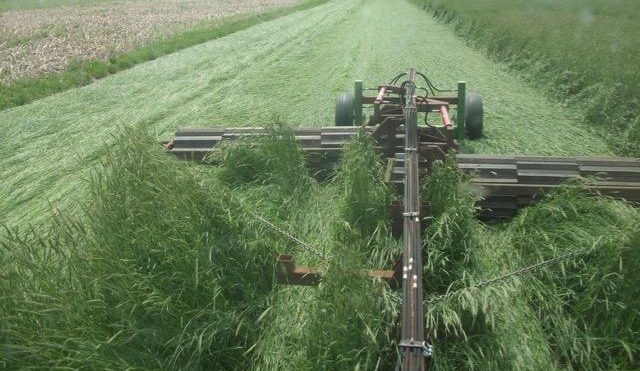Spring is nearly here, and for many, it’s time to think about our cover crop termination. Some cover crop species may have winterkilled, and others may be harvested or used for grazing; however, many stands will require termination.
Termination Methods
Planting Green/Roller-Crimper
Planting green is planting a grain crop into a recently-terminated or living cover crop that is terminated shortly after planting. Planting green allows you to maximize cover crop biomass production and provide a longer period of weed suppression. However, a variety of management issues must be considered, including delayed planting due to cold and wet soils, reduced soil moisture availability to the cash crop in dry years, increased risk of insect pests such as slugs and seed corn maggots, and interference with soil-applied herbicides. Additionally many farmers who plant green make significant planter upgrades to achieve a uniform stand, including row cleaners, downforce systems, and spiked closing wheels.
Roller-crimpers may be used in planting green operations to terminate certain cover crop species such as winter rye. It is essential that the cover crop is in the boot stage or flowering to prevent regrowth; however, it is also important to terminate the cover crop prior to seed production. Roller-crimping creates a thick mat of residue that aids in weed suppression but is still subject to the management considerations listed above.
Herbicides
Herbicides are a highly effective option for cover crop termination. When selecting herbicides, it is important to consider the cover crop species and growth stage, weeds that need to be controlled, the proceeding cash crop, and weather conditions. Glyphosate is commonly used to control both grass and broadleaf species, and the addition of a growth regulator herbicide, dicamba or 2,4- D, will improve the control of broadleaf species. Practical Farm Research data has shown that dicamba is more effective at controlling glyphosate-resistant marestail in a burndown application compared with 2,4-D. Ultimately, there are a variety of herbicide options that may be used to terminate cover crops. It is important to be aware of any plant-back restrictions for the proceeding cash crop.
Cover crops must be actively growing for systemic herbicides to translocate. Once seed production starts, however, herbicide translocation will be altered, and herbicide uptake by mature plants is greatly reduced. In both cases, achieving successful termination is less likely. As for the environment, air temperatures of at least 45°F or greater are required for these herbicides to work, and cloudy weather that limits cover crop growth may also inhibit systemic herbicides. Contact herbicides such as Gramoxone® or Liberty® are not as weather-dependent, but killing the entire plant, including the roots, may be difficult.
Tillage
Using tillage for termination is not preferred as it reduces the benefits of reduced tillage and increased soil organic matter that cover crops provide; however, if tillage is used, it provides the benefits of weed control in the spring and faster cover crop breakdown as the cover crops are incorporated into the soil. For tillage to be effective for termination, the cover crop roots must be sufficiently disturbed and uprooted. Moldboard and chisel plows are highly effective but may require multiple passes, while implements that perform light tillage are not very effective.
Final Recommendations
1. Make your plan now and be ready to terminate when the time is right.
2. Many states offer recommendations for cover crop termination. Additional resources include the Sustainable Agriculture Research and Education Program or the Midwest Cover Crop Council.
3. Unless planting green, cover crops should be terminated one to two weeks prior to cash crop planting. Cereal rye and annual ryegrass should be terminated when plants are greater than 18 in. and 6 in. tall, respectively. and as long as they have broke dormancy and are actively growing.
4. Check with your crop insurance representative for termination timing guidelines in your county to make sure your cash crop is insurable. Contact your local Beck’s representative for even more information.
~ Aaron Booker, Ph.D. – Field Agronomist

